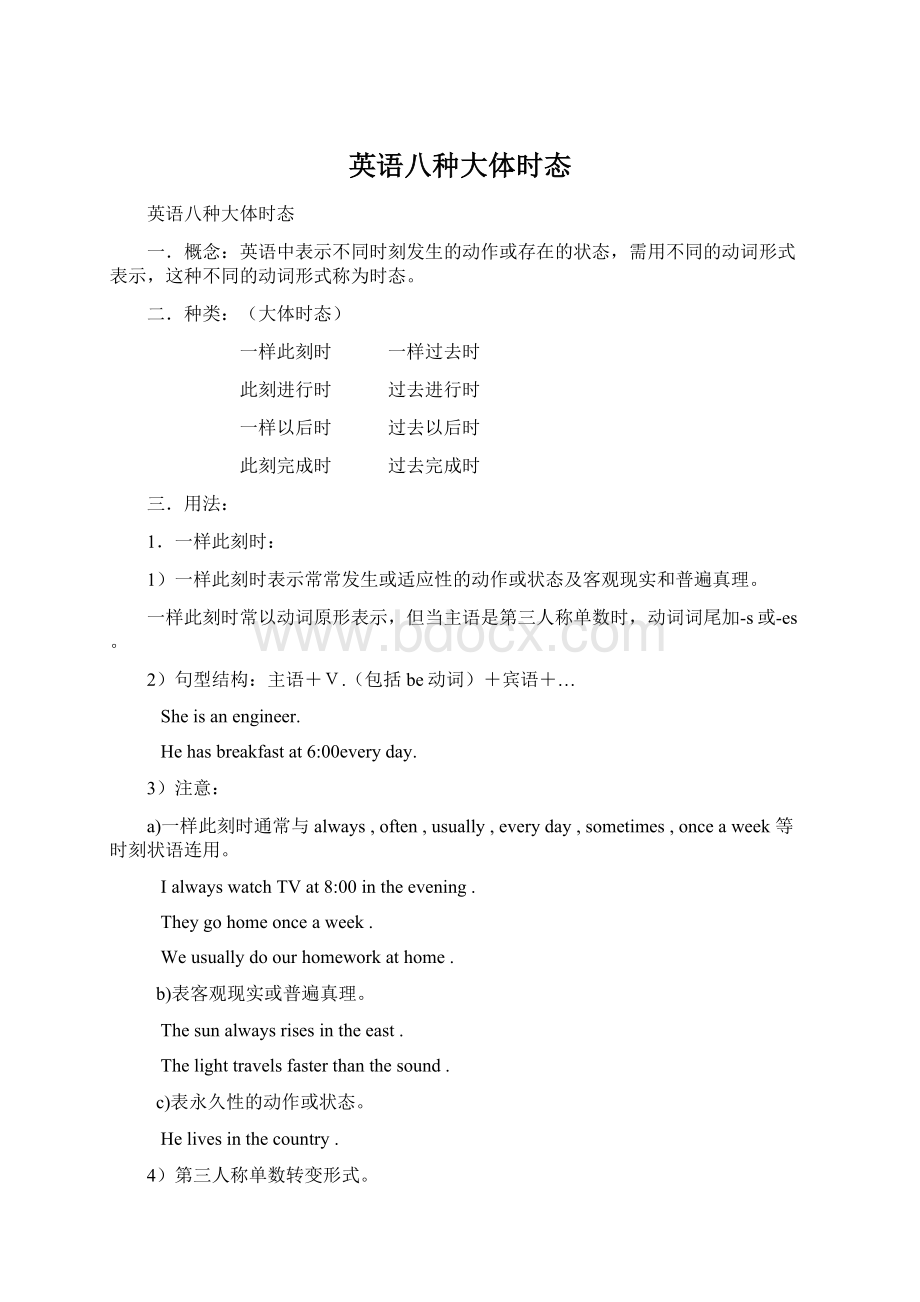英语八种大体时态.docx
《英语八种大体时态.docx》由会员分享,可在线阅读,更多相关《英语八种大体时态.docx(10页珍藏版)》请在冰豆网上搜索。

英语八种大体时态
英语八种大体时态
一.概念:
英语中表示不同时刻发生的动作或存在的状态,需用不同的动词形式表示,这种不同的动词形式称为时态。
二.种类:
(大体时态)
一样此刻时 一样过去时
此刻进行时 过去进行时
一样以后时 过去以后时
此刻完成时 过去完成时
三.用法:
1.一样此刻时:
1)一样此刻时表示常常发生或适应性的动作或状态及客观现实和普遍真理。
一样此刻时常以动词原形表示,但当主语是第三人称单数时,动词词尾加-s或-es。
2)句型结构:
主语+V.(包括be动词)+宾语+…
Sheisanengineer.
Hehasbreakfastat6:
00everyday.
3)注意:
a)一样此刻时通常与always,often,usually,everyday,sometimes,onceaweek 等时刻状语连用。
IalwayswatchTVat8:
00in theevening.
Theygohomeonceaweek.
Weusuallydoourhomeworkathome.
b)表客观现实或普遍真理。
Thesunalwaysrisesintheeast.
Thelighttravelsfasterthanthesound.
c)表永久性的动作或状态。
Helivesinthecountry.
4)第三人称单数转变形式。
a)一样情形动词在词尾加-s.
come---comes speak---speaks work---works live---lives
b)以o,s,x,ch,sh结尾的单词在词后加-es.
do---does go---goes finish---finishes brush---brushes
fix---fixes pass---passes watch---watches
c)以“辅音字母+y”结尾的单词变y为i加-es.
Study---studies carry-carries cry---cries
d)以“元音字母+y”结尾的单词直接加-s.
play---plays stay---stays
例句:
咱们天天晚上九点做作业。
我在早上七点半起床。
他天天七点去上班。
咱们常常下午打篮球。
他喜爱音乐。
地球围绕太阳转。
火车六点动身。
5)否定句和疑问句。
a)-----Heisanengineer.
-----Heisn’tanengineer.
-----Isheanengineer?
-----Yes,heis./No,heisn’t.
b)----Wegetupat7:
30in themorning.
-----Wedon’tgetupat7:
30in themorning.
-----Doyougetupat7:
30in themorning?
-----Yes,wedo./No,wedon’t.
c)----Helikesmusic.
-----Hedoesn’tlikemusic.
-----Doeshelikemusic?
-----Yes,hedoes./No,hedoesn’t.
2.一样过去时
1)一样过去时表示发生在过去的动作或存在的状态,通常与表示过去的时刻状语yesterday,lastnight,someyearsago,in1990,inthosedays.等连用。
Iwasastudent6yearsago.
Iwentto Beijing lastyear.
Theysawafilmlastnight.
2)句型结构:
主语+V.过去时+宾语+…
例句:
昨天他很忙。
去年他抽烟了。
两年前他去参军了。
他在1990年归天了。
3)否定句和疑问句。
a)----Hewasbusyyesterday.
-----Hewasn’tbusy.
-----Washebusy?
-----Yes,hewas./No,hewasn’t.
b)----Hesmokedlastyear.
-----Hedidn’tsmokelastyear.
-----Didhesmokelastyear?
-----Yes,hedid./No,hedidn’t.
c)----Hejoinedthearmyin1990.
-----Hedidn’tjoinedthearmyin1990.
-----Didhejointhearmyin1990?
-----Yes,hedid./No,hedidn’t.
4)动词过去式转变规则。
a)一样情形下的词加-ed.
work---worked call----called laugh----laughed
Explain----explained finish----finished knock----knocked
b)以不发音的字母e结尾的单词直接加-d.
live----lived change----changed smoke----smoked die----died
graduate----graduated drive----drove
c)以“辅音字母+y”结尾的单词,变y为i加-ed.
study----studied carry----carried cry----cried
try----tried marry----married
d)以“元音字母+y”结尾的单词直接加-ed.
play----played stay----stayed
e)以“一个元音字母+一个辅音字母”结尾的单词应先双写那个辅音字母然后再加-ed.
stop----stopped plan----planned pat----patted
f)动词不规则转变:
do----did go----went come----came run----ran write----wrote
begin----began drink----drank keep----kept leave----left sleep----slept
make----made lie----lay dig----dug eat----ate know----knew
cut----cut set----set let----let read----read hurt----hurt
例句:
我前天拿走了这本书。
去年我买了一辆自行车。
天天晚上我听音乐。
她通常待在家里。
两天前我完成了这项工作。
温习:
1)I (be)ateacher2yearsago.
2)He (be)astudentnow.
3)He (do)hishomeworkathomeeveryday.
4)They (join)thePartyin1998.
5)We (noteat)applesyesterday.
6)We (notplay)basketballeveryday.
7)He (notgo)homeonceaweek.
8)Iam 16yearsold.(划线部份提问)
9)Igotowork at8:
00 everymorning.(划线部份提问)
10)TheyjoinedthePartyin 1990.(划线部份提问)
11)Iwentto Beijing lastyear.(划线部份提问)
3.一样以后时
1)表示以后发生的动作或存在的状态,常与表以后的时刻状语tomorrow,thedayaftertomorrow,nextSunday,soon,inafewdays等连用。
2)句型结构:
主语+will/shall+V.原形+…(第一人称用shall)
Ishallgoto Shanghai tomorrow.
Theywillhaveameetingnextweek.
----Shewillbe20yearsold.
----Willshebe20yearsold?
----Yes,shewill./No,shewon’t.
3)主语+will/shall+V.原形+…
be(am,is,are)goingto
TheywillhaveameetingnextSunday.
(will=aregoingto)
----WhatwilltheydonextSunday?
----Whenwilltheyhaveameeting?
4)beaboutto+V.原形
Iamabouttoleaveschool.
不能与表示时刻的副词连用。
Theyareabouttosetout.(√)
Theyareabouttosetoutsoon.(×)
温习题:
(do)hishomeworkatschooleveryday.
(finish)theirworkyesterday.
(visit)theirfarmnextyear.
4.我半小时后要吃午饭。
5.他将骑自行车去学校。
6.他们下周日将去买汽车。
4.过去以后时
1)过去以后时是立足于过去某时,从过去的观点看将要发生的动作或状态。
要紧用于宾语从句中。
2)大体结构:
主语+would/should was/weregoingto+V.原形+…
Hesaidthathewouldhaveameetingnextweek.
(Hesaysthathewillnaveameetingnextweek.)
Theysaidweshouldleaveschooltomorrow.
(Theysayweshallleaveschooltomorrow.)
5.此刻进行时
1)此刻进行时表示此刻或此刻这段时刻正在进行的动作。
通常与now,atpresent 等时刻状语连用。
2)大体结构:
主语+be(am,is,are)+v-ing+…
Youarelisteningtomecarefullynow.
Sheiswritingaletterthisyear.
Look!
Theyaredancing.
WearestudyingEnglishatpresent.
It’sraininghardnow.
3)动词此刻分词的组成
① 一样动词直接在词后加-ing
do–doing read-reading
work–working think–thinking
study–studying go–going
watch–watching jump-jumping
② 以不发音的字母e 结尾的动词,应先去掉 e 然后加 –ing
like–liking take–taking
leave–leaving live–living
receive–receivingdance–dancing
come–coming smoke–smoking
write-writing
③ 以“一个元音字母 + 一个辅音字母”结尾的动词,应先双写那个辅音字母然后再加-ing
stop–stopping begin–beginning
dig–digging swim–swimming
run–running sit–sitting
(注意:
listen–listening open–opening eat–eating
rain–raining sleep-sleeping)
4)
6 .过去进行时
1) 表示过去某一时刻或某时期时刻正在进行的动作, 通常与 at6:
00yesterday,atthis/thattimeyesterday,when 引导的时刻状语等连用。
2) 大体结构 主语+be(was/were)+v-ing+…
1. Itwasrainingat7:
00thedaybeforeyesterday.
2. Theywerebuildingareservoiratthistimelastwinter.
3. We werereading whentheteachercamein.
Weweren’treading…
Wereyoureading…
Whatwereyoudoingwhentheteachercamein.
3) 例句 1. 前天那个时候Tom 正在看电影。
2. 上周日四点咱们正在游泳。
3.师看见咱们时咱们正在玩扑克。
4. I____(do)myhomeworkyesterday.
5. He____(do)hishomeworkat5:
00yesterday.
6. He____(do)hishomeworknow.
7.此刻完成时
1) 1. 表示过去发生的动作对此刻造成的阻碍
2.表示过去某时刻已经开始一直持续到此刻的动作或状态
通常与下列时刻状语连用 uptonow,inthepast,recently,by…,for5years,since1994,sofar,already,yet,ever,just…
2) 大体结构 主语+have/has+(动词过去分词)
1. I’vefinishedthiswork.
2. Hehaseverbeento Australia.
3. Ihavenotheardfromherrecently.
4. Ihavealreadyread thisbook.
Haveyouread…?
Yes,Ihave. No,Ihaven’t.
Whathaveyouread?
3) 过去分词的组成 (规则转变同过去式的组成)
不规则转变如下
do did done
go went gone
eat ate eaten
come came come
have had had
write wrote written
be was/were been
see saw seen
hear heard heard
swim swam swum
drink drank drunk
give gave given
forget forgot forgotten
take took taken
keep kept kept
sleep slept slept
teach taught taught
buy bought bought
tell told told
make made made
cut cut cut
hurt hurt hurt
read read read
let let let
4) 注意
1. 含有终止意义或暂短意义的动词不能与 for,since 引导的一样时刻状语连用。
(buy,begin,die,come,go,join,leave 等)
A) Ihaveboughtabook.
Ihaveboughtabookfor3day. (wrong)
Ihavehadabookfor3years.
B) Hehavejoinedthearmyfor3years. (wrong)
Hehasbeeninthearmyfor3years.
Hejoinedthearmy3yearsago.
C) Hehasbeendeadfor3years.
Hedied2yearsago.
Itis2yearssincehedied.
Hehasdiedfor2years. (wrong)
D) Hehasgoneto Australia.
Hehasbeento Australia.
2. 此刻完成时与一样过去时的区别 (时刻状语的区别)
I___(hear)formherrecently/yesterday.
3. 例句:
他已经阅读了这本书。
咱们到目前为止已学习了两千个单词。
他们居住在中国三年了。
他看这部电影两次了。
Bob 自从 1997 年在这所学校教学。
8.过去完成时
1) 表示动作发生在过去某一时刻之前已经完成的动作或状态, 强调“过去的过去”, 常与 bythetime,bytheendof…,before,by 等引导时刻的状语连用。
2) 大体结构 主语+had+ 动词过去分词 +…
WhenIgottothecinemayesterdaythefilmhadbegunalready.
昨天当我抵达电影院时电影已经开始了。
HehadlearnedEnglishbeforehecamehere.
他来这儿之前已经学会英语了。
Hehadaughtthisclassfor3yearsbythetimeIlefttheschool.
当我离开那个学校为止 他已教那个班级三年了。
BytheendoflasttermIhadlearned2000Englishwords.
到这学期末我已学会了2000 个英语单词。
时态部份总温习题
I.Fillintheblanks.
1. Weusually___(get)upat7:
00everymorning.
2. She___(watch)TVwhensheheardaloudknockatthedoorthistimeyesterday.
3. Mymother___(come)heretomorrow.
4. Look!
Someone___(dance)there.
5. WeiHua’sbrother___(join)thearmyin1995.
6. He___(write)aletterthisafternoon.
7. Rice___(grow)inthesouthof China.
8. Shesaid___(go)to Japan nextyear.
9. We___(study)2,000wordssincewecametotheschool.
10. Bytheendoflasttermhe___(teach)thatclassfor2years.